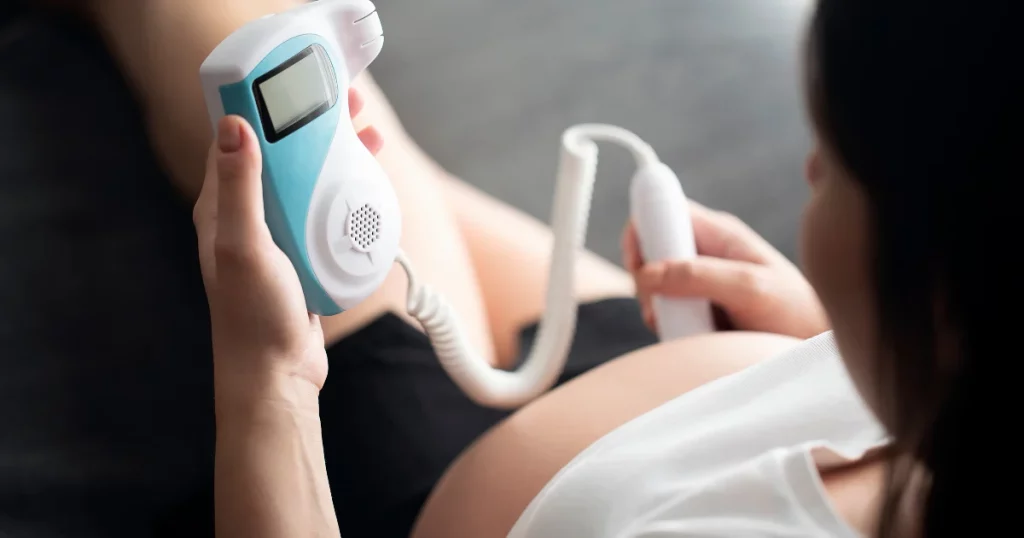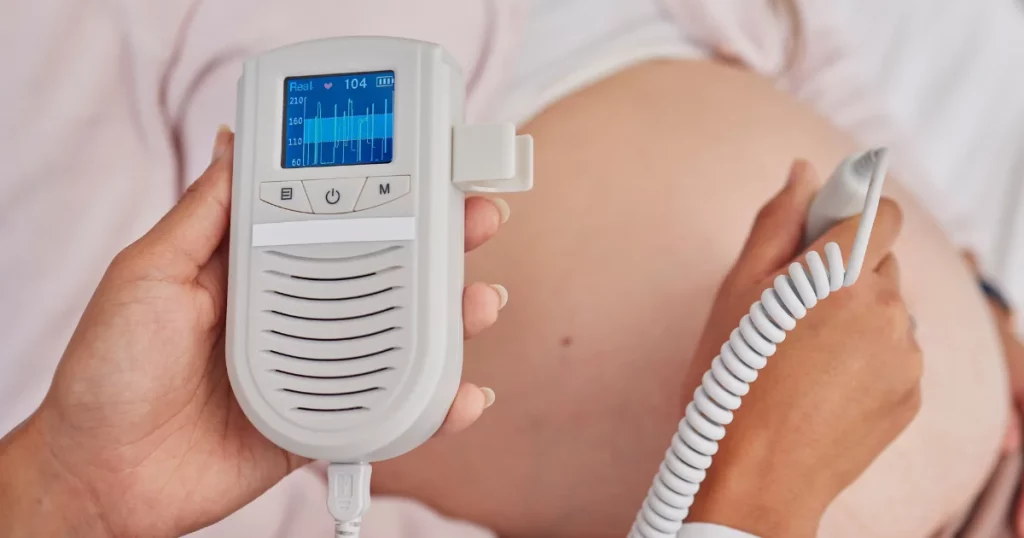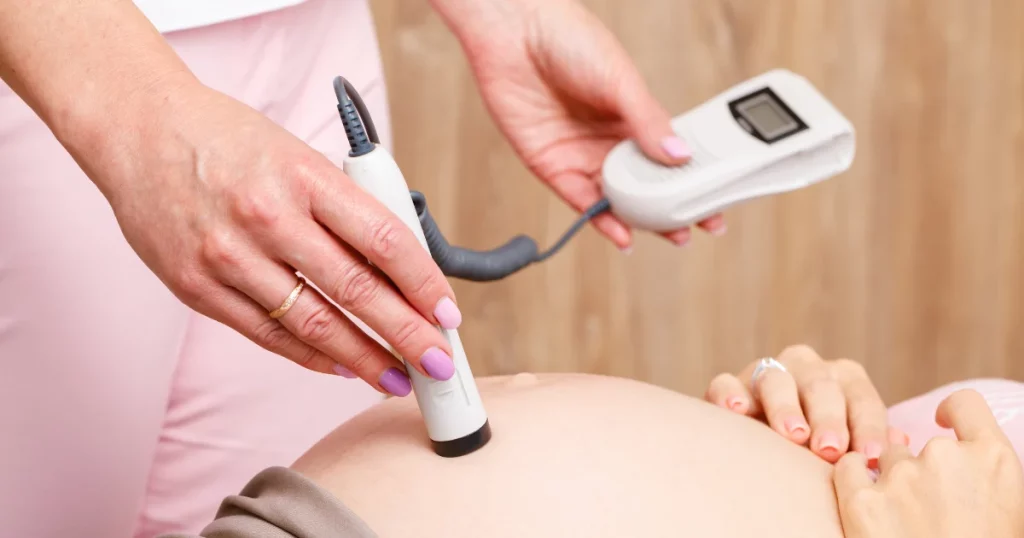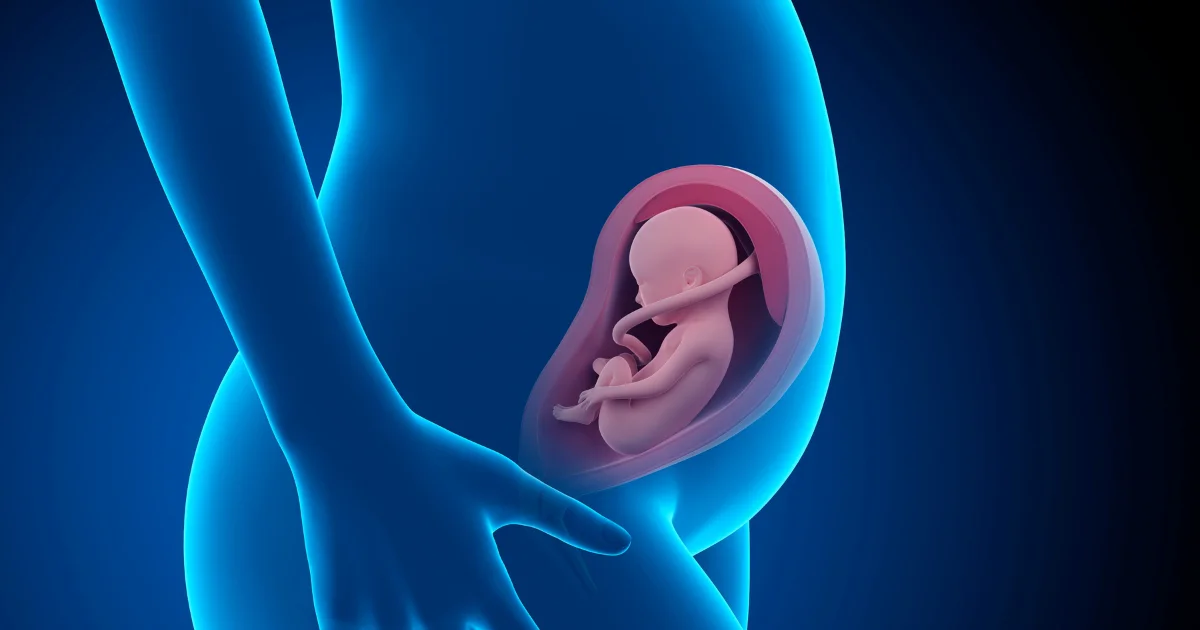Fetal Dopplers have become an invaluable tool for expectant parents, allowing them to listen to their baby’s heartbeat in the comfort of their home. This ultimate guide provides comprehensive insights into Fetal Doppler Baby Heartbeat Monitor, covering everything from how they work to tips for optimal usage.
Table of Contents
Understanding Fetal Doppler Baby Heartbeat Monitor
Fetal Dopplers stand as vital devices in prenatal care, offering expectant parents and healthcare professionals a means to listen to the baby’s heartbeat. This section delves into the fundamental aspects of Fetal Dopplers, shedding light on their principle of operation and the importance of safe usage.
1. Principle of Operation
Fetal Dopplers operate based on ultrasound technology, leveraging the Doppler effect to detect and amplify the fetal heartbeat. Here’s a brief exploration of their principle of operation:
- Ultrasound Waves: Fetal Dopplers emit ultrasound waves, which are sound waves at frequencies higher than those audible to the human ear.
- Doppler Effect: As these ultrasound waves encounter moving objects, such as blood cells in the fetal heart, the Doppler effect causes a change in the frequency of the reflected waves.
- Heartbeat Detection: By detecting and analyzing these frequency changes, Fetal Dopplers can translate them into audible sound, allowing healthcare providers and parents to listen to the rhythmic beats of the baby’s heart.
2. Safe Usage
It is crucial to underscore the safe and non-invasive nature of the Fetal Doppler Baby Heartbeat Monitor when used responsibly and according to guidelines. Here are key points to consider:
- Non-Invasive Monitoring: Fetal Dopplers provide a non-invasive way to monitor the baby’s heartbeat, posing minimal risk to both the mother and the developing fetus.
- Guidelines Adherence: To ensure safety, users must adhere to established guidelines for Fetal Doppler usage. This includes appropriate gestational age for use and limiting the duration of monitoring sessions.
- Professional Guidance: While Fetal Dopplers are available for home use, seeking professional guidance on proper usage is advisable. Healthcare providers can provide instructions tailored to individual pregnancies, ensuring optimal and safe use.
- Reassurance and Bonding: Fetal Dopplers offer a unique opportunity for parents to bond with their unborn child and gain reassurance about the baby’s well-being. However, moderation in use is key to preventing undue anxiety and reliance on self-monitoring.
In essence, understanding the underlying principles of Fetal Doppler Baby Heartbeat Monitor and embracing safe usage practices contribute to a positive and informed prenatal experience. These devices serve as valuable tools for fostering a connection between parents and their unborn child while prioritizing the safety and well-being of both mother and baby.
Also read: A Deep Dive into Fetal Scalp Monitoring in Delivery Supervision
Choosing the Right Fetal Doppler
As expectant parents, the joy of anticipating a new life often comes with the desire to monitor the baby’s well-being and hear the reassuring sound of their heartbeat. Fetal Doppler Baby Heartbeat Monitor provides a means to achieve this connection and offer peace of mind. Here are some factors given below to consider when choosing the right fetal Doppler.
1. Type of Fetal Doppler
- Handheld Dopplers: Portable and easy to use, handheld Dopplers are suitable for home monitoring. They are user-friendly and allow for flexibility in monitoring sessions.
- Clinic-Grade Dopplers: These are often used by healthcare professionals and offer advanced features. While more sophisticated, they may require professional expertise for optimal use.
2. Frequency of Use
- Home Monitoring: If you prefer the convenience of monitoring at home, a handheld Doppler designed for personal use is ideal. Look for models that are user-friendly and come with clear instructions.
- Clinical Use: If you anticipate frequent monitoring or have specific medical considerations, a clinic-grade Doppler may be suitable. These are designed for more extensive use and often come with additional features.
3. Gestational Age
- Early Pregnancy: In the early stages of pregnancy, especially before 12 weeks, it may be challenging to detect the fetal heartbeat. Look for Dopplers with higher sensitivity for early gestational age.
- Mid to Late Pregnancy: As the pregnancy progresses, most Dopplers become effective in detecting the heartbeat. Consider a model with adjustable sensitivity to accommodate different stages.
4. Additional Features
- Digital Display: Some Dopplers come with a digital display that shows the baby’s heart rate, providing a visual element to the monitoring experience.
- Recording Capability: Certain models allow you to record the baby’s heartbeat, providing a cherished keepsake and the opportunity to share the experience with others.
5. Ease of Use
- Probe Design: Consider the design of the Doppler probe. A probe with good ergonomics and ease of handling contributes to a more comfortable monitoring experience.
- User Instructions: Choose a Doppler that comes with clear and comprehensive user instructions. Understanding how to use the device properly is crucial for accurate monitoring.
Selecting the right Fetal Doppler Baby Heartbeat Monitor involves thoughtful consideration of personal preferences, gestational age, and desired features. Whether opting for a handheld Doppler for home use or a clinic-grade model for more extensive monitoring, the goal is to enhance the bonding experience and provide reassurance during the exciting journey of pregnancy. Always follow the manufacturer’s guidelines and consult with healthcare professionals for guidance on proper usage.
When to Start Using a Fetal Doppler

The anticipation of hearing the baby’s heartbeat is a significant aspect of the pregnancy journey, and a Fetal Doppler Baby Heartbeat Monitor can provide an avenue for this joyful experience. However, knowing when to start using a Fetal Doppler is essential for optimal results and peace of mind.
1. Gestational Age
- Early Pregnancy: In the early stages of pregnancy, particularly before 12 weeks, the baby’s heartbeat may not be consistently detectable with a Doppler. The fetal heart is still developing, and its small size makes detection challenging.
- Mid to Late Pregnancy: As the pregnancy progresses beyond the first trimester, the baby’s heart becomes more developed and is generally easier to detect using a Fetal Doppler.
2. Experience with Doppler Use
- First-Time Users: If you are new to using a Fetal Doppler Baby Heartbeat Monitor, it’s advisable to start around the 12th week of pregnancy. This allows time for the baby’s heart to develop and increases the likelihood of successful detection.
- Experienced Users: If you have prior experience with Fetal Doppler use and are familiar with the device, you may attempt monitoring a bit earlier, around the 10th week. However, it’s crucial to manage expectations, as detection may still be sporadic.
3. Healthcare Professional Guidance
- Consultation with Healthcare Provider: Before initiating Fetal Doppler use, consider consulting with your healthcare provider. They can offer guidance based on your specific medical history, pregnancy progression, and any potential risk factors.
- First Ultrasound Appointment: Many expectant parents hear the baby’s heartbeat for the first time during routine ultrasound appointments. This visual confirmation by a healthcare professional can provide assurance and help set expectations for Doppler use.
The decision on when to start using a Fetal Doppler Baby Heartbeat Monitor varies among expectant parents and depends on factors such as gestational age, prior experience, and individual comfort levels. It’s essential to approach Doppler use with realistic expectations and, when in doubt, seek guidance from healthcare professionals. Remember that successful detection may take time, and consistency in use is crucial for an enhanced bonding experience.
How to Use a Fetal Doppler for Monitoring Your Baby’s Heartbeat: A Step-by-Step Guide
Using a Fetal Doppler at home can be a rewarding experience for expectant parents who wish to listen to their baby’s heartbeat between medical appointments. However, proper usage is crucial to ensure accurate results and a positive monitoring experience. This step-by-step guide provides instructions on how to use a Fetal Doppler Baby Heartbeat Monitor effectively.
Step 1: Gather Your Supplies
Ensure you have all the necessary items before starting:
– Fetal Doppler device
– Ultrasound gel (water-based)
– Towel or tissue for cleanup
– Comfortable and quiet space
– Optional: Lubricating gel if ultrasound gel is not available
Step 2: Choose the Right Time
Select a time when you are relaxed, and your baby is typically active. The best time is usually in the evening when you can lie down comfortably without disturbances.
Step 3: Position Yourself
Lie down on your back or recline in a comfortable position. Applying gel on a bare belly is more effective, but if you’re not comfortable, wear loose clothing or expose a small area for gel application.
Step 4: Apply Ultrasound Gel
Squeeze a small amount of ultrasound gel onto the area where you plan to place the Doppler. If ultrasound gel is unavailable, you can use a lubricating gel as an alternative.
Step 5: Turn on the Fetal Doppler
Switch on the Doppler device and set it to a low volume initially. Hold the device by the handle and make sure the probe is clean.
Step 6: Locate the Heartbeat
Place the Doppler probe on the gel-covered area and move it slowly around your lower abdomen. Start below your belly button and angle the probe downward. Listen for a rapid, rhythmic sound, which is the baby’s heartbeat.
Step 7: Adjust the Angle and Pressure
Experiment with the angle and pressure of the Doppler probe until you locate the heartbeat. Move the probe gently, and don’t press too hard to avoid discomfort.
Step 8: Be Patient
Finding the heartbeat may take a few minutes, especially in the early weeks. If you can’t locate it immediately, try repositioning the probe or waiting for your baby to shift.
Step 9: Record the Heartbeat
Once you find the heartbeat, you can use a recording device or your phone to capture the sound. This allows you to share the experience with your partner or loved ones.
Step 10: Clean Up
After monitoring, clean the Doppler probe with a tissue or towel, and wipe off any excess gel from your abdomen.
Using a Fetal Doppler Baby Heartbeat Monitor at home requires patience and practice. If you experience difficulty or have concerns, consult with your healthcare provider. Regularly monitoring your baby’s heartbeat can provide reassurance and enhance the bonding experience during pregnancy.
Interpreting Fetal Heart Sounds with a Fetal Doppler

The advent of Fetal Dopplers has empowered expectant parents to listen to their baby’s heartbeat from the comfort of their homes. Learning to interpret fetal heart sounds using a Fetal Doppler is a valuable skill that enhances the bonding experience and provides reassurance. This guide aims to offer comprehensive insights into the nuances of interpreting fetal heart sounds with a Fetal Doppler Baby Heartbeat Monitor.
1. Identifying the Fetal Heartbeat: The fetal heartbeat is distinct from other sounds, resembling a rapid, rhythmic, and pulsating noise. It’s crucial to distinguish the baby’s heartbeat from maternal blood flow or other bodily sounds.
2. Normal Fetal Heart Rate Range: The normal fetal heart rate typically falls between 120 and 160 beats per minute (BPM). A consistent and regular heartbeat within this range is indicative of a healthy baby.
3. Locating the Heartbeat: The position where you detect the heartbeat can provide insights into the baby’s position. Guidance on where to place the Doppler probe for optimal results.
4. Changes in Heart Rate: Understanding that temporary variations in heart rate can occur due to fetal movements or external factors. The importance of consulting healthcare providers if persistent or concerning changes are noted.
5. Monitoring Fetal Movements: Highlight the correlation between fetal heart monitoring and tracking the baby’s movements. Encourage regular monitoring to ensure an active and healthy baby.
6. Seeking Professional Advice: Emphasize the importance of consulting healthcare professionals for any concerns or difficulties in interpreting fetal heart sounds. Healthcare providers can offer guidance and reassurance based on their expertise.
Interpreting fetal heart sounds with a Fetal Doppler Baby Heartbeat Monitor is a rewarding and bonding experience for expectant parents. This guide aims to equip you with the knowledge and confidence to navigate the process effectively, fostering a deeper connection with your baby and ensuring a proactive approach to their well-being.
Tips for Optimal Usage
- Quiet Environment: Recommend using the Doppler in a quiet environment to enhance the clarity of the fetal heartbeat.
- Patience and Persistence: Advise users to be patient, as locating the heartbeat might take time, especially in early pregnancy.
Frequency of Use
- Balanced Approach: Encourage a balanced approach to using the Fetal Doppler, avoiding excessive or unnecessary use.
- Consultation with Healthcare Provider: Emphasize the importance of regular prenatal check-ups with healthcare providers in addition to home monitoring.
Potential Challenges and Limitations in Interpreting Fetal Heart Sounds with a Fetal Doppler
While Fetal Doppler Baby Heartbeat Monitor provide an invaluable tool for expectant parents to connect with their baby, it’s essential to be aware of potential challenges and limitations associated with their use. Understanding these factors contributes to a more informed and cautious approach when interpreting fetal heart sounds. Here are some potential challenges and limitations:
1. Detection Challenges: Factors such as maternal obesity or excess abdominal tissue may make it challenging to locate and detect the fetal heartbeat accurately. The position of the baby within the uterus can affect the Doppler’s ability to capture clear and consistent heart sounds.
2. Confusion with Maternal Sounds: Maternal blood flow, gastrointestinal sounds, or even the mother’s heartbeat may be misconstrued as the fetal heartbeat. Novice users might find it difficult to differentiate between fetal and maternal sounds, leading to potential misinterpretations.
3. Variable Heart Rate: Fetal heart rates can naturally vary, and distinguishing between normal variations and potential concerns can be challenging. Users may experience difficulty in identifying transient changes in heart rate related to fetal movements or other external factors.
4. User Experience and Skill Level: Inexperienced users may face a learning curve in terms of proper Doppler usage, probe placement, and recognizing normal fetal heart sounds. User interpretation may improve with practice and guidance from healthcare professionals.
5. False Reassurance or Anxiety: While hearing a reassuring fetal heartbeat is generally comforting, there is a risk of false reassurance if users misinterpret sounds or overlook potential issues. Conversely, difficulties in finding the heartbeat may cause unnecessary anxiety.
6. Interference and Signal Quality: External factors such as interference from electronic devices, low battery levels, or poor Doppler signal quality can impact the clarity of heart sounds. Ensuring a quiet environment and proper maintenance of the Fetal Doppler can mitigate these issues.
7. Professional Confirmation: It’s crucial to recognize that the Fetal Doppler is a supplementary tool and not a substitute for professional monitoring. Healthcare providers possess the expertise to assess fetal well-being comprehensively and should be consulted for confirmation and guidance.
Interpreting fetal heart sounds with a Fetal Doppler Baby Heartbeat Monitor is a valuable and rewarding experience, but it comes with inherent challenges. Users should approach Fetal Doppler use with a balance of excitement and caution, understanding the tool’s limitations and seeking professional guidance for comprehensive fetal monitoring.
Emotional Well-being
- Managing Expectations: Remind users that fetal movement and position can impact Doppler readings, influencing the ease of heartbeat detection.
- Seeking Support: Encourage open communication with healthcare providers if there are concerns or difficulties in using the Doppler.
Safety Precautions
- Time Limitations: Suggest a reasonable time limit for each session to avoid prolonged exposure to ultrasound waves.
- Consistent Monitoring: Reinforce the importance of consistent prenatal care by healthcare professionals for a comprehensive assessment of fetal well-being.
Final Words
This ultimate guide aims to empower expectant parents with the knowledge needed for the safe and effective use of the Fetal Doppler Baby Heartbeat Monitor. While they offer a unique and heartwarming experience, it’s crucial to balance their use with regular healthcare check-ups to ensure the overall health and well-being of both the expectant parent and the baby.




